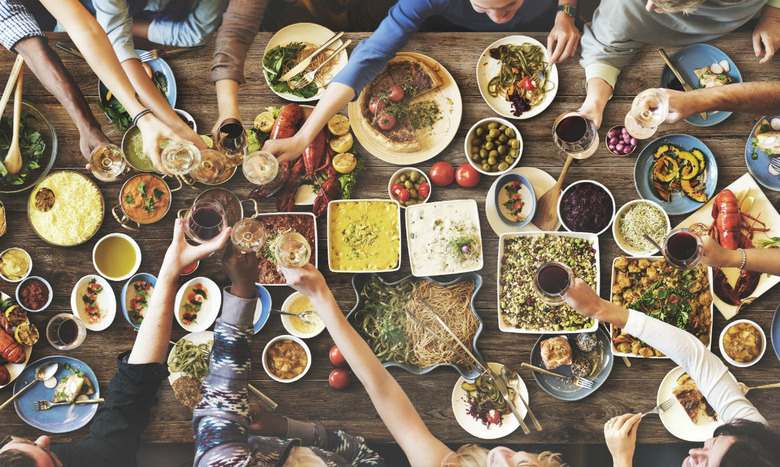How To Cook A Dinner Party Feast That Nobody Will Be Allergic To
The rise of allergies and intolerances in the last decade have made hosting a dinner party a scary challenge. Every individual seems to have at least one dietary requirement — and that probably includes you, the host, as well — which means you must think outside the box when you're planning the menu.
Normally, catering for one dietary requirement is totally possible: You can definitely manage to cook a vegetarian feast, or a gluten-free entrée. However, there will occasionally be that one guest who really can't eat anything, or your guests will come together with individual needs that will result in a menu that has to be gluten-free, vegan, soy-free, nut-free, and dairy-free. Instead of canceling your dinner party or un-inviting guests with the most annoying allergies, you can cook around their needs. Instead of panicking and deciding this dinner will have to consist of a green salad followed by a fruit salad, treat it as a culinary challenge. Show your skills in the kitchen by taking on all their requirements and cooking up a meal everyone can eat, and one that doesn't taste like cardboard.
The first thing to do is to understand the severity of all your guests' allergies and intolerances, and get the exact details. You don't want to be making any assumptions about their requirements. Sending someone away in an ambulance because you thought that they wouldn't be allergic to sesame seeds when they said they had a nut allergy, is not the way you want to end the evening.
Start your meal with some shared appetizers. Having a selection of dishes for people to nibble on will allow you to work around dietary requirements. Label each bowl carefully so your guests can figure out what they can and can't eat without having to ask you every time. A selection of crudités and crackers served with a range of dips such as hummus and guacamole, is a delicious way to get the party started.
The entrée is obviously going to be slightly more challenging: Carrot batons and puréed chickpeas aren't the ideal main meal fodder. Depending on what the restrictions are, a vegetable based dish served with rice and a bountiful green salad is normally a safe and popular option. This baked eggplant with chickpeas and green chile is packed with flavor, and yet is made only of vegetables, pulses, herbs, and spices. A spicy, fragrant dhal is always a safe option if you've got a table full of gluten-free vegetarians, and this mushroom chia risotto is a fantastic rich and creamy vegan main.
For dessert, you're probably going to have to steer clear of your rich, dairy-laden favorites. Fruit salad may sound like a dull way to end the meal, but there are so many ways to make it more interesting, like this pineapple with smashed mint sugar, or this recipe for sweetly grilled fruit. If you're a keen baker, and don't want to let those lactose- and gluten-free guests get in the way of your skills, try these vegan chocolate coconut cupcakes, for a surprisingly rich, diet-friendly, and sweet treat.
